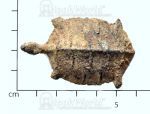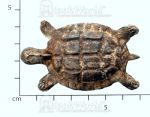We've tried to ensure the information displayed here is as accurate as possible. Should there be any inaccuracies, we would be grateful if you could let us know at info@ipohworld.org . All images and content are copyright.
(Please click on the thumbnail for a bigger image.)
Perak Tin Animal Money, The Tortoise - (1)





The pictures show five tin ingots in the shape of a tortoise, typical of those from Perak and recognised universally as Perak Animal Money. Each would have the value of a small fraction of one tin cent based on the amount of tin by weight which could be exchanged for one Spanish Silver dollar. At least three of these carry the unmistakable signs of having been buried or laid on the sea bed for very many years. One of these s on display in Han Chin Pet Soo Museum.
The absolute origin of this form of primitive currency is lost in time, but it is recorded in a number of reliable publications that it was a combination of superstition, folklore, magic or religion associated with starting a new tin mine, irrespective of whether the mine was Malay or Chinese. This exercise involved the attendance of a traditional medicine man cum religious leader (a Pawang or Bomoh) to supervise the mining and smelting of the first ore from the new mine, thus achieving harmony with the local spirits and demons. The first ingots would be in the form of an animal and in some cases represented the sacrificial animal (perhaps a goat or a cockerel) slaughtered as part of the ceremony of digging the first sod. They were cast in either carved clay or stone moulds. Presented to the owner of the mine or the local village chief as a good luck charm, they were recognized as barter items to trade or purchase with. Consequently other animals were also made as currency, although it was the weight of tin, not the shape, which gave the value. Hence simple shapes like cones, balls and rough cylinders were also employed. These were generally known as "Bidors" in Perak.
Other Malay States also had their tin money, for example Kedah had a fighting cock perched on a series of rings attached to its base and Negeri Sembilan had a variety of different, miscellaneous-shaped ingots.
Referring to the above picture, this particular shape is believed to have started out as a simple shell-backed ingot, but influenced by the Chinese miners, grew head tail and legs, as shown, for to the Chinese the tortoise means long life and happiness. Second from the left in the picture is the least defined shape and is therefore probably the earliest at around 1750. There were however other animal shapes in Perak (and to a limited extent in Selangor), the most popular being the bird, clam, cockerel, crocodile, elephant (an early Hindu influence?), fish, goat and starfish. The above is a synopsis of a variety of different documents and other sources, including the Museum Negara publication, "Tin Hat and Animal Money" by Shaw, W., Kassim Haji Ali, M (1970), held in the ipohWorld library.
Let the buyer beware! A set of forgeries of animal money came on to the market in the early 1980s. They are easily recognisable by their lack of old patina and 'frosted' surface. Mostly they also carry Chinese characters, look more like cookies than anything else, and are said to be from Malacca. It is claimed these have only recently been identified as they have been lying, undiscovered, on the beds of rivers or the sea for the last 500 years or so. The International coin collecting community does not believe in them!
There are more examples of Perak tin money / currency in this archive.
To read about the Fish as Perak Animal Money, click here.
To read about the Clam as Perak Animal Money, click here.
To read about the Rooster as Perak Animal Money, click here.
To read about the Starfish and its Mould as Perak Animal Money, click here.
To read about the Bird as Perak Animal Money, click here.
To read about the Goat as Perak Animal Money, click here.
To read about a large Tortoise as Perak Animal Money, click here.
To read about a large Crocodile as Perak Animal Money, click here.
To read about a small crocodile as FMS Animal Money, click here.
To read about the history of Perak Tin Ingot Money, click here.
To see an early Perak Tampang and Tampang history, click here.
To read about the book "Tin Hat and Animal Money", click here.